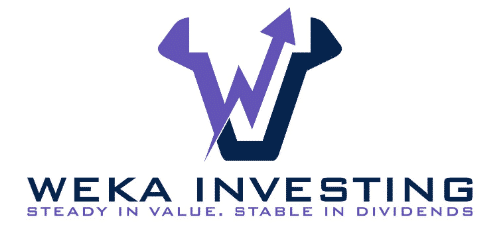What Are Closed-End Funds (CEFs) and Why Should Dividend Investors Care?
Closed-End Funds (CEFs) are investment vehicles with a fixed number of shares. They offer great advantages for dividend investors due to their high income potential and tax-efficient distributions. CEFs, actively managed by professionals, also provide diversification across sectors and regions. However, they also carry risks such as limited liquidity and market volatility. As dividend investors, understanding the workings and benefits of CEFs is vital. It greatly enhances our investment strategies and provides a steady income stream. There’s more to uncover about how CEFs could become a potent tool in your investment arsenal.
Key Takeaways
- Closed-End Funds (CEFs) are investment structures with fixed shares, often offering high income potential for dividend investors.
- CEFs can provide tax-efficient distributions and diversification across sectors, regions, and asset classes, offering a versatile tool for portfolio diversification.
- They can pose higher risk due to trading at a premium or discount to net asset value (NAV), and potential capital losses during market volatility.
- CEFs often deliver high and regular dividends, making them attractive for investors seeking a predictable income stream and the compounding effect of reinvested dividends.
- As CEFs are managed by professionals, investors gain access to expert management strategies, risk mitigation, and the potential for higher returns.
Understanding Closed-End Funds (CEFs)
To truly harness the potential of dividend investing, it’s essential we first grasp the concept of Closed-End Funds (CEFs). CEFs are a type of investment vehicle which, unlike mutual funds and exchange-traded funds, have a fixed number of shares. Now, let’s dig into specifics to fully understand these powerful financial instruments.
Often misunderstood, CEF Taxation is an area we need to clarify. Unlike traditional investments, CEFs don’t have capital gains distribution, which means we aren’t taxed until we sell the shares. This gives us greater control over our tax liabilities.
Leveraged Strategies are another critical aspect of CEFs. By borrowing at short-term interest rates and investing in longer-term securities, CEFs can generate additional income. However, we must be aware that, while leveraging can enhance returns, it can also amplify losses.
CEF Convertibility is a unique feature that allows us to convert our CEF shares into a predetermined number of shares of the underlying assets, providing us with additional flexibility and freedom.
The Regulatory Framework for CEFs differs from that of other investment vehicles. They’re regulated by the Investment Company Act of 1940, which provides investor protections related to leverage, governance, and transparency.
Lastly, understanding Secondary Market Operations is crucial for us. CEFs trade on the open market, much like stocks. The price of a CEF can deviate from its Net Asset Value (NAV), leading to opportunities for us to buy shares at a discount or sell at a premium.
How Do CEFs Work?
Diving into the mechanics of Closed-End Funds, we find that they operate quite differently than other investment vehicles. They’re structured to raise a fixed amount of capital through an initial public offering (IPO) and then traded on the open market like a stock. This unique structure leads to several operational nuances.
A key aspect of CEFs is the taxation rules, known as CEF Taxation. Unlike mutual funds, CEFs don’t have to distribute capital gains to investors. This allows for better reinvestment opportunities and offers more freedom to the investor in managing their tax liabilities.
When it comes to the Inflation Impact, CEFs can provide a decent level of protection. The reason is their ability to use leverage to potentially earn higher returns. However, it’s a double-edged sword, as leverage also amplifies losses, which is one of the CEF Risks.
The Regulatory Framework surrounding CEFs is stringent. They’re regulated by the Investment Company Act of 1940, which provides investor protections by establishing rules around disclosures, leverage limits, and oversight.
The Structure of CEFs
Understanding the structure of Closed-End Funds (CEFs) is vital for investors as it’s this unique setup that sets them apart from other investment options. CEFs are publicly traded investment companies that raise a fixed amount of capital through an initial public offering (IPO). This capital is then managed by an investment adviser who actively manages the fund’s portfolio.
The CEF regulations mandate that these funds operate with a board of directors or trustees, providing a layer of oversight for investors. Unlike other funds, the number of shares is fixed, hence not subject to the inflows and outflows that can affect open-ended funds. This distinct structure can impact fund performance, as CEFs may trade at a premium or discount to their net asset value (NAV), depending on investor demand.
As with any investment, CEFs come with certain risks. One such risk is the possibility of the fund’s shares trading at a discount to its NAV. This means investors could potentially buy shares for less than their actual worth, but it also means they could sell them for less than their NAV.
Tax implications are another important aspect to consider. Since CEFs often aim to generate income through dividends, understanding the tax treatment for these dividends is key.
Lastly, CEF valuation is an essential consideration. Since CEFs trade like stocks, their price is determined by the market. But unlike stocks, CEFs also have a NAV, which represents the underlying value of the assets in the fund. Understanding these aspects can give investors a clearer picture of the potential benefits and drawbacks of investing in CEFs.
Differences Between CEFs and ETFs
While CEFs have unique attributes that set them apart, it’s equally important to grasp how they differ from Exchange-Traded Funds (ETFs), another popular investment vehicle. CEFs and ETFs may seem similar on the surface, but there are key differences that can have a major impact on your investment strategy.
- Trading: Unlike CEFs, which trade at a premium or discount to their net asset value (NAV), ETFs tend to trade very close to their NAV due to the creation/redemption process. This ETF Trading feature often results in fewer price discrepancies and more predictable trading patterns.
- Taxation: CEF Taxation can be more intricate than that of ETFs. With CEFs, income and capital gains are generally passed onto investors and are subject to tax. ETFs, on the other hand, often have tax advantages due to the ‘in-kind’ creation and redemption process, which can minimize capital gains distributions.
- Risk and Reward: CEF Risks can be higher than those of ETFs due to their potential to trade at significant discounts or premiums to NAV. However, this can also present opportunities for greater returns. On the flip side, ETF Advantages include the potential for lower risk due to their trading mechanism and broader diversification.
- Performance: CEF Performance can be more volatile due to their fixed pool of shares. ETFs, by contrast, can issue new shares or redeem existing ones to meet demand, potentially offering more stability.
Understanding these differences is vital for any investor. It allows you to choose an investment vehicle that aligns with your financial goals and risk appetite, giving you the freedom to manage your investments effectively.
Advantages of Investing in CEFs
Let’s now turn our attention to the benefits of investing in Closed-End Funds (CEFs).
From high income potential to portfolio diversification benefits, there’s a lot on the table.
We’ll also touch on liquidity and accessibility, professional fund management, and lower market correlation, all key advantages that make CEFs an attractive choice for dividend investors.
High Income Potential
One of the most compelling advantages of investing in Closed-End Funds (CEFs) is their high-income potential, particularly for dividend investors seeking steady income streams. This potential stems from four key factors:
- Tax implications: CEFs often offer tax-efficient distributions, enhancing your overall returns.
- Risk assessment: By diversifying across different sectors and regions, we can mitigate risk and promote stable income.
- CEFs’ sustainability: Given their fixed share count, CEFs can take long-term investment positions, often leading to higher yields.
- Dividend reinvestment: CEFs often provide a reinvestment plan – an opportunity to compound your earnings over time.
Incorporating CEFs into your portfolio balance could lead to significant income potential, providing financial freedom and peace of mind.
Liquidity and Accessibility
Beyond the high-income potential of CEFs, their liquidity and accessibility present another compelling reason to include them in your investment portfolio.
Unlike other investment vehicles, CEFs have high trading frequency, allowing investors to buy and sell freely in the open market, much like stocks. This flexibility is a significant advantage for investors seeking freedom in their investment choices.
Moreover, CEFs have relaxed redemption policies which make them easily accessible to investors. Brokerage considerations are minimal as CEFs can be purchased through any brokerage account.
As for tax implications, CEFs often offer tax-efficient income streams. Finally, initial investment requirements for CEFs are typically lower than other funds, making them an attractive option for investors with various financial capabilities.
Portfolio Diversification Benefits
Investing in closed-end funds often provides us with an excellent opportunity for portfolio diversification, which is a crucial strategy to manage investment risks effectively.
- Risk Mitigation: Diversifying through CEFs allows us to spread investment risks across various sectors and industries, reducing the potential impact of a single poor performer.
- Asset Allocation: With CEFs, we can invest in a broad range of assets, including bonds, stocks, real estate, and commodities, thereby balancing our portfolio’s risk and return potential.
- Global Exposure: CEFs often invest worldwide, granting us access to growth and opportunity on a global scale.
- Tax Considerations and Retirement Planning: CEFs can provide tax-efficient income streams, which can be a crucial part of a prudent retirement strategy.
In essence, CEFs offer a versatile tool for portfolio diversification.
Professional Fund Management
Another significant advantage of investing in CEFs is the access to professional fund management, which can greatly enhance the potential for higher returns and risk management. A well-chosen manager brings expertise in crafting successful investment strategies, with a keen eye for fund performance and regulatory considerations. They’ll navigate complex financial landscapes, making informed choices that might elude less seasoned investors.
We’re talking about professionals who live and breathe market trends and have a knack for risk management. They’ll do the heavy lifting, giving you the freedom to enjoy the benefits without the stress of constant monitoring. The right manager selection can make a world of difference in your portfolio’s performance, making CEFs a smart choice for dividend investors.
Lower Market Correlation
In addition to the benefits of professional fund management, CEFs also offer the advantage of lower market correlation. This means that CEFs’ performance isn’t as tightly tied to the ups and downs of the overall market. This can be particularly advantageous in times of market volatility.
- Correlation Coefficients: CEFs typically have lower correlation coefficients to broad market indices, offering potential diversification benefits.
- Risk Assessment: Lower market correlation can help in smoothing out investment returns, reducing the risk associated with market fluctuations.
- Investment Strategies: CEFs allow for unique approaches not available in other investment vehicles, providing more freedom in asset allocation.
- Asset Allocation: Lower correlation to the market means CEFs can play a pivotal role in asset allocation, providing an additional layer of diversification and reducing portfolio risk.
Potential Drawbacks of CEFs
While CEFs can provide attractive dividends, it’s crucial we also consider some potential disadvantages.
High expense ratios, limited liquidity risks, and volatility in premiums or discounts are among the key drawbacks.
In addition, potential capital losses and a lack of transparency can also pose challenges for investors.
High Expense Ratios
High expense ratios often cast a shadow over the allure of Closed-End Funds (CEFs), posing as a potential drawback for dividend investors. While we can’t ignore the Expense Ratio Impact on returns, it’s important to analyze the cost efficiency of these funds.
- Fee Reduction Strategies: High fees can eat into your returns. Employing fee reduction strategies can help mitigate this issue.
- Expense Ratio Impact: Expense ratios have a substantial influence on your returns. It’s essential to understand their implications.
- Cost Efficiency Analysis: Analyzing the cost efficiency of a fund helps assess whether the potential return justifies the expenses.
- Fund Expense Comparisons: Comparing fund expenses helps identify the most cost-effective options.
Limited Liquidity Risks
Traversing the murky waters of limited liquidity, one of the potential drawbacks of Closed-End Funds (CEFs), can present significant risks for dividend investors. The trading frequency of CEFs isn’t as high as other investment types, which can lead to liquidity issues. If we need to sell, we may be forced to do so at an unfavorable time due to market fluctuations, leading to potential losses.
Additionally, regulatory constraints and redemption restrictions can further limit the liquidity of CEFs. These can be affected by asset valuation, which fluctuates based on market conditions and the fund’s underlying investments. So, while CEFs can offer attractive dividends, we must be mindful of these liquidity risks to maintain our financial freedom.
Premium or Discount Volatility
Despite considering the liquidity risks, we mustn’t overlook another significant pitfall of CEFs – the volatility in premium or discount. This volatility could greatly impact investments, taking us on an unwanted rollercoaster ride. Here’s why:
- Essential Mechanisms: CEFs often trade at a discount to their net asset value (NAV), which can fluctuate unpredictably.
- Volatility Impacts: Sudden swings in the premium or discount could erode the potential for high dividend yields.
- Premium Fluctuations: CEFs could swing to a premium, tempting us to buy high, only to later fall to a discount.
- Volatility Management: Managing these swings requires constant monitoring and adjustment, which may not align with our desire for investment freedom.
Understanding these Discount Dynamics is essential for us to navigate the potential pitfalls of CEFs effectively.
Potential Capital Losses
One key drawback we need to contemplate when investing in CEFs is the potential for capital losses. Despite their allure, these funds aren’t immune to market fluctuations and can result in a significant erosion of investment capital if they don’t perform well.
Consider the following table:
| Risk Evaluation | Loss Mitigation | Redemption Strategies |
|---|---|---|
| Identifying the extent of potential loss | Implementing strategies to minimize loss | Determining exit strategies |
| Analyzing the impact of market volatility | Understand tax implications of losses | Timing the market for selling |
| Emphasizing on capital preservation | Diversifying portfolio to spread risk | Consider tax-efficient selling |
As freedom-seeking investors, we must consider the tax implications of our investment decisions and adopt loss mitigation strategies. Remember, capital preservation is key, and a thorough risk evaluation is indispensable.
Lack of Transparency
In addition to potential capital losses, another significant drawback of CEFs that we should consider is the lack of transparency. This obscurity can often manifest itself in four main ways:
- Opaque Valuations: The intrinsic value of a CEF can be challenging to determine, leaving investors in the dark.
- Regulatory Challenges: CEFs can sometimes fall through the regulatory cracks, further complicating investor protection.
- Information Asymmetry: Fund managers may have access to more information than investors, creating an uneven playing field.
- Market Manipulation: This lack of transparency can, unfortunately, lead to potential market manipulation.
We believe in freedom, and that includes financial freedom. By understanding these risks, we can better equip ourselves to navigate the complex world of CEF investing with confidence and clarity.
The Role of Dividends in CEFs
Let’s explore the pivotal role dividends play in Closed-End Funds (CEFs), providing regular income to investors while simultaneously offering potential for capital appreciation. Dividend reinvestment is a key strategy here, where dividends are automatically used to buy more shares of the fund. This compounding effect can greatly boost your long-term returns.
However, dividends aren’t free money. They’ve tax implications that need to be considered. In most cases, dividends are taxed as ordinary income, not at the lower capital gains rate. This can eat into your net returns, especially if you’re in a high tax bracket.
The dividend frequency of CEFs is typically monthly or quarterly, more regular than many other investment options. This provides a predictable income stream, a boon for those seeking financial freedom.
When it comes to dividend yield comparison, CEFs often shine. They can offer higher yields than other investment types, like ETFs or mutual funds. But remember, a high yield can also indicate higher risk, so do your due diligence.
Why CEFs Matter to Dividend Investors
As we turn our focus to why closed-end funds (CEFs) matter to dividend investors, it’s crucial to recognize the unique role these funds play.
The specifics of dividends in CEFs and how they compare to traditional funds can provide valuable insights for potential investors.
We’ll unpack these topics, offering a detailed analysis to help you make informed decisions about your investment strategy.
Understanding CEFs
Closed-End Funds (CEFs) hold a unique position in the investment landscape, providing a compelling opportunity for dividend investors due to their distinct structure and operational features.
- CEF Taxation: They offer unique tax advantages that can optimize your income stream.
- CEF Regulations: A firm understanding of these guidelines is essential for maneuvering potential pitfalls and protecting your investments.
- CEF Risks: We’ll shed light on the risks associated with CEFs, from market volatility to liquidity issues, to help you make informed decisions.
- Investing Strategies with CEFs: With the right approach, CEFs can enhance your portfolio’s overall performance.
- CEFs in Retirement Planning: They provide a reliable income source, a critical aspect to contemplate for your golden years.
Dividends in CEFs
For dividend investors, the distinctive nature of CEFs can offer a significant advantage, particularly due to their potential for high and regular dividend payouts. The dividend frequency in CEFs is often monthly or quarterly, providing steady income. Investors have the option for dividend reinvestment, thereby increasing their holdings and potential returns.
However, bear in mind the tax implications of these dividends. They’re typically taxed as income, which may impact your overall returns. An important aspect to ponder is dividend sustainability. This depends on the fund’s ability to generate income and maintain its payouts.
Additionally, dividend growth is a key factor. It’s essential to choose CEFs that consistently increase their dividends, providing an effective hedge against inflation.
CEFs Vs Traditional Funds
When comparing closed-end funds (CEFs) to traditional funds, it’s clear that CEFs offer distinct advantages for dividend investors, thanks to their unique structure and potential for high, regular dividend payouts.
- Fund selection: CEFs provide a wider range of investment options, giving us the freedom to tailor our portfolio according to our risk assessment and investment strategy.
- Investment strategy: CEFs allow for active management. This flexibility can lead to higher potential returns.
- CEFs taxation: Unlike traditional funds, CEFs often distribute income as dividends which may be taxed at a lower rate.
- Portfolio rebalancing: CEFs’ fixed number of shares can aid in portfolio rebalancing, providing a level of stability that traditional funds sometimes lack.
Tips for Choosing the Right CEFs
Exploring the world of Closed-End Funds (CEFs) can appear daunting, but with the right tips and strategies, we can help you in selecting the most appropriate ones for your portfolio. It’s important to take into account factors including CEF Taxation, CEF Trading, Fund Manager Selection, CEF Risk, and CEF Performance.
On the topic of CEF Taxation, it’s important to grasp the tax implications of your investments. CEFs can offer tax-efficient distributions, but the specifics will depend on the fund’s investment strategy and structure. Be sure to incorporate this into your decision making.
When it comes to CEF Trading, keep in mind that these funds trade on an exchange just like stocks. This means prices can fluctuate based on supply and demand, not just the value of the underlying assets. Be aware of this potential volatility.
Fund Manager Selection is another essential consideration. The performance of a CEF largely depends on the expertise of the fund manager. Review their track record and investment strategy to make sure it aligns with your financial goals and risk tolerance.
Speaking of risk, understanding CEF Risk is indispensable. CEFs can use leverage to potentially enhance returns, but this can also increase risk. Make sure you’re comfortable with the level of risk before investing.
What Makes a Successful CEF Investment
So, what exactly makes a successful CEF investment? We believe it’s a mix of understanding CEFs taxation, staying abreast of CEFs regulation, gauging the market trends impact, comprehending the CEFs redemption policies, and deploying smart risks mitigation strategies.
- Understanding CEFs Taxation: Complex as it may seem, understanding taxation rules can have a significant impact on your returns. CEFs aren’t taxed like regular mutual funds; instead, they might provide certain tax advantages, like the ability to pass along tax credits to investors. Know your tax obligations and plan accordingly.
- Staying Abreast of CEFs Regulation: As an investor, you must keep an eye on regulatory changes that might affect CEFs. Remember, regulations are designed to protect you, the investor. Understanding them can help you avoid potential pitfalls and capitalize on opportunities.
- Gauging the Market Trends Impact: CEFs are impacted by market trends, just like any other investment. Being aware of market movements can help you make informed decisions about when to buy or sell.
- Comprehending CEFs Redemption Policies: Unlike open-end funds, CEFs have fixed shares and their redemption policies can be more complex. Understanding these policies can help you plan your exit strategy and avoid unexpected surprises.
- Deploying Smart Risks Mitigation Strategies: Investing always involves risks. However, by diversifying your portfolio, staying informed, and regularly reviewing your investments, you can mitigate these risks.
Future Perspectives on CEFs for Dividend Investors
Looking ahead, we see significant potential in CEFs for dividend investors, given the unique opportunities these funds present in the ever-evolving investment landscape. We anticipate an increase in sector-specific CEFs, offering investors the chance to diversify their portfolios and take advantage of growth opportunities in various industries.
Let’s explore into the specifics. CEF taxation, for example, is an important consideration. Many CEFs offer tax advantages that can enhance overall returns. For instance, return of capital distributions aren’t taxed as ordinary income, which can result in lower tax liabilities for investors.
Next, we’ve the inflation impact. With rising inflation, the income streams from CEFs can provide a hedge, since many of these funds invest in assets whose value increases with inflation. This can protect purchasing power and provide real income growth for investors.
Dividend reinvestment is another key aspect to take into account. Many CEFs offer dividend reinvestment plans that allow investors to automatically reinvest their dividends into additional shares. This can lead to compounding returns over time, an attractive feature for long-term investors.
Frequently Asked Questions
What Are Some Popular Examples of Closed-End Funds (Cefs) in the Market Today?
We’re often asked about popular CEFs in today’s market. Two standouts are Pimco Dynamic Income Fund (PDI) and Eaton Vance Tax-Managed Global Diversified Equity Income Fund (EXG). Both offer unique CEF advantages like managed payout policies.
However, they also carry risk factors, requiring savvy CEF management and investment strategy. It’s important to note CEF liquidity can be limited, so we advise doing thorough research before investing.
Are There Any Alternative Investment Options Similar to Cefs?
Absolutely, there are oceans of alternative investment options akin to CEFs. We’re talking about ETFs, mutual funds, and REITs. Each comes with its own CEF risks, but they offer opportunities for portfolio diversification.
They vary in CEF valuation, trading techniques, and performance analysis. We’re all for financial freedom, so exploring these alternatives could be a wise move. It’s about charting your own financial course, after all.
Can CEFS Be Included in a Retirement Portfolio?
Yes, we can include CEFs in our retirement portfolio. They offer income stability, portfolio diversification, and potentially strong CEFs performance.
However, we must also be aware of CEF risks, like market volatility and liquidity issues.
If we’re careful and do our research, CEFs can be a beneficial part of our retirement strategy. They can help us achieve the financial freedom we’re aiming for in our golden years.
How Do Economic Downturns Affect the Performance of Cefs?
Economic downturns can rock CEFs like a stormy sea, testing their resilience. During these times, CEFs’ performance can fluctuate due to market volatility. However, with smart downturn strategies, we can navigate these choppy waters.
Despite the recession impact, CEFs often show a surprising toughness. They can provide a layer of investment protection, acting as a lifeboat when other assets sink. We must remain vigilant and adapt to protect our investments.
What Are the Tax Implications Associated With Investing in Cefs?
We’re exploring the tax implications of investing in CEFs. They offer tax benefits including potential capital gains and dividend taxation advantages. If you’re holding these funds in taxable accounts, you might qualify for tax deductions.
However, they can also increase your tax liability, so it’s necessary to understand these aspects. They’re not just about attractive yields; tax considerations play a critical role in the total returns.
We shouldn’t neglect the tax aspect while investing.
Conclusion
In the grand tapestry of investing, CEFs are a unique thread, offering potential benefits to savvy dividend investors. They can be a powerful tool in our arsenal, providing income and diversity.
Yet, like any investment, they demand careful selection and understanding. As we navigate the future, let’s keep our eyes on the horizon of CEFs, recognizing their potential to enrich our investment portfolio.
The right CEF could be a golden ticket, a gateway to a world of dividends yet untapped.

Dr. Lincoln C. Wood teaches at the University of Otago in New Zealand. He is an avid investor and educator. He loves cash flow, income, and dividends when investing. He likes to buy undervalued companies with strong advantages and earnings growth.







